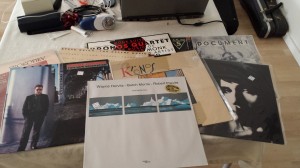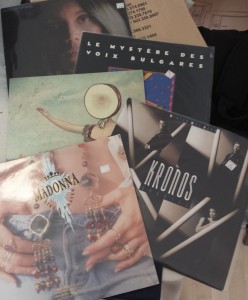Analog is the new mid-life crisis
I knew it would happen eventually, despite my best efforts to resist. One thing I try to bristle against is fashion, even if on some level I agree with said fashion.
And right now, vinyl is fashionable.
It’s a fast-growing format, according to the New York Times. Though only 1.4 percent of the total market, vinyl record sales has seen an 18 percent growth since 2011. Manufacturers, however, say they press far more than sales indicate.
But my resistance to this resurgence is rooted in memory. I bought records when I was the age of the young people snatching them up now. From 1985 to 1989, I built a collection of nearly 90 some odd records. Then the demands of convenience encroached on my purchasing habits.
A cassette tape Walkman was easier to bring on a bus ride than a turntable, and eventually, a portable CD player offered a better listening experience than a Walkman. Back then, compact discs were priced higher than records and cassette tapes because they were considered the “premium” format.
The industry transitioned away from those analog formats and trained consumers to accept premium prices as baseline.
So imagine my shock to see new releases and reissues on vinyl that cost double or triple what I paid originally. Warner Bros. reissued R.E.M.’s Green on vinyl, and it sells for roughly $25. I don’t think I paid more than $10 when I bought my copy in 1989. Of course, my original is a lot more brittle than the 180-gram reissue.
Most of my cassettes are gone, but I held onto my vinyl collection through two interstate moves. So I have a fondness for the format, despite using my record player very sparingly since I bought it in 1998.
I’ve resisted this vinyl resurgence because, yes, I’m a cheap bastard. It goes against my muscle memory to buy a vinyl record for more than $20. If I’m going to drop that much money, there had better be more than one disc in the package.
That pretty much changed back in late May 2013.
I bought some new stereo speakers, a “business expense” to hear how Eponymous 4 recordings would sound on something other than computer speakers, car speakers and earphones. Of course, I haven’t exactly used these speakers exclusively for business purposes.
I grew up listening to my record collection on a pair of huge furniture speakers that offered a fairly decent listening experience. My new speakers reminded me of those days, so I started to play my vinyl records through them.
Oh damn.
I played some out-of-print Emmylou Harris albums I bought at the Austin Record Convention, back when file sharing was nary a twinkle in Shawn Fanning’s eye. (These albums, which include Cimarron, Evangeline, Thirteen, Ballad of Sally Rose and Last Date are now available as downloads.) Next were albums I had upgraded to CD but originally bought on vinyl.
The floodgates started to rumble when I purchased an entirely new record: In the Aeroplane Over the Sea by Neutral Milk Hotel. I can’t say I was terribly impressed with how that album was transferred to vinyl. I played R.E.M.’s Green immediately afterward and was struck by how loud it was. Lesson: Bob Ludwig is a god among men.
That got me thinking — how do the albums I bought on cassette and on CD during that transitional period sound on vinyl? And what about those albums I discovered after the transition that were created before CDs?
The catalyst that put on this downward spiral of collecting was Lisa Stansfield’s Affection, an album from 1989 I rediscovered a few years back. I spotted a vinyl copy at Sonic Boom Records but didn’t buy it. I went back a few days later thinking it would be there … and it wasn’t. Someone else recognized the same potential.
And now I’m on this mission to find those albums I could have bought on vinyl but didn’t. It includes catalog I subsequently discovered long after the transition to CD.
Of particular interest are Nonesuch releases after 1985. Robert Hurwitz assumed leadership of the label the year before and signed up the likes of Steve Reich, John Adams, Kronos Quartet, John Zorn, Wayne Horvitz and Bill Frisell.
I’ve already managed to find some Kronos Quartet vinyl, and I snagged one Steve Reich LP of The Desert Music.
I’ve limited this vinyl hunt to pre-1991 catalog. These releases were recorded and mastered with vinyl in mind.
I’m skeptical about how an album recorded to maximize the dynamic range of a compact disc would retain all that information on an analog format. If the Neutral Milk Hotel record is any indication, not very well.
Even with those restrictions, it’s quite a lot of music to cover. They range from rarities as Bring Yr Camera by Wayne Horvitz’s band The President to dollar-bin specials such as the Trio album by Dolly Parton, Emmylou Harris and Linda Ronstadt.
And if there’s a curiosity to be had for cheap, I’m not opposed to drop the cash. Case in point: Exposure by Exposé. I downloaded this album a number of years ago and was surprised by how durable it was for ’80s radio pop. I’ve been ambivalent about scouring for a used copy on CD, but when I spotted it on vinyl for $1, I bought it.
Is this nostalgia in which I’m indulging? Analog, it seems, is my version of a midlife crisis. It’s probably cheaper than Porsche.
Or maybe I’m just rediscovering what I knew when I was young. Record players require far more attention than an MP3 player. The medium can be easily damaged. The playback mechanism requires care in operating. In short, records require you to pay attention.
A playlist with 48 hours worth of music is easy to push into the background, a habit I’ve developed over a number of years. Records force interactivity, and it’s tough to ignore music when the medium on which it’s played demands something more physical than tapping a touchscreen.


